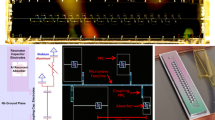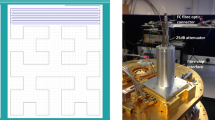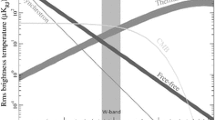Abstract
The PRobe far-Infrared Mission for Astrophysics (PRIMA) is working to develop kinetic inductance detectors (KIDs) that can meet the sensitivity targets of a far-infrared spectrometer on a cryogenically cooled space telescope. An important ingredient for achieving high sensitivity is increasing the fractional-frequency responsivity. Here, we present a study of the responsivity of aluminum KIDs fabricated at the Jet Propulsion Laboratory. Specifically, we model the KID’s temporal response to pair-breaking excitations in the framework of the Mattis–Bardeen theory, incorporating quasiparticle recombination dynamics and the pair-breaking efficiency. Using a near-IR laser, we measure time-resolved photon pulses and fit them to our model, extracting the time-resolved quasiparticle density and the quasiparticle recombination lifetime. Comparing the fit to the known energy of the laser provides a measurement of the pair-breaking efficiency. In addition to photon-sourced excitations, it is important to understand the KID’s response to phonon-sourced excitations from cosmic rays. We measure the rate of secondary cosmic rays detected by our devices and predict the dead time due to cosmic rays for an array in L2 orbit. This work provides confidence in KIDs’ robustness to cosmic ray events in the space environment.




Similar content being viewed by others
References
J. Zmuidzinas, Superconducting microresonators: physics and applications. Annu. Rev. Condens. Matter Phys. 3, 169–214 (2012). https://doi.org/10.1146/annurev-conmatphys-020911-125022
N. Cothard et al., Parallel plate capacitor aluminum kids for future far-infrared space-based observatories (J. Low. Temp. Phys, This Special Issue, 2023)
L. Foote et al., High-sensitivity kinetic inductance detector arrays for the probe far-infrared mission for astrophysics (J. Low. Temp. Phys, This Special Issue, 2023)
S. Hailey-Dunsheath et al., Development of aluminum lekids for balloon-borne far-ir spectroscopy. J. Low Temp. Phys. 193, 968–975 (2018). https://doi.org/10.1007/s10909-018-1927-y
M.S. Khalil et al., An analysis method for asymmetric resonator transmission applied to superconducting devices. J. Appl. Phys. (2012). https://doi.org/10.1063/1.3692073
L.J. Swenson et al., Operation of a titanium nitride superconducting microresonator detector in the nonlinear regime. J. Appl. Phys. (2013). https://doi.org/10.1063/1.4794808
S. Golwala, Exclusion limits on the wimp-nucleon elastic-scattering cross section from the cryogenic dark matter search. PhD Thesis, University of California, Berkeley, 417–421 (2000)
A.G. Korezov et al., Quasiparticle-phonon downconversion in nonequilibrium superconductors. Phys. Rev. B (2000). https://doi.org/10.1103/PhysRevB.61.11807
A. Fyhrie et al., Decay times of optical pulses for aluminum cpw kids. J. Low Temp. Phys. (2020). https://doi.org/10.1007/s10909-020-02377-7
K. Karatsu et al., Mitigation of cosmic ray effect on microwave kinetic inductance detector arrays. Appl. Phys. Lett. (2019). https://doi.org/10.1063/1.5052419
Planck Collaboration: Planck 2013 results. x. hfi energetic particle effects: characterization, removal, and simulation. A & A 571(A10) (2014) https://doi.org/10.1051/0004-6361/201321577
A. Sinclair, Github repository https://github.com/adriankaisinclair/primecam_gateware_design
J. Burgoyne, Github repository https://github.com/TheJabur/primecam_readout
A. Sinclair et al., Ccat-prime: Rfsoc based readout for frequency multiplexed kinetic inductance detectors. Annu. Rev. Condens. Matter Phys. (2022). https://doi.org/10.1117/12.2629722
Acknowledgements
The research was carried out at the Jet Propulsion Laboratory, California Institute of Technology, under a contract with the National Aeronautics and Space Administration (80NM0018F0610). This work was funded by the NASA (Award No. 141108.04.02.01.36)—to Dr. C. M. Bradford. We would like to thank Thomas Stevenson for helpful discussions on the source of gamma rays in the laboratory.
Author information
Authors and Affiliations
Corresponding author
Additional information
Publisher's Note
Springer Nature remains neutral with regard to jurisdictional claims in published maps and institutional affiliations.
Rights and permissions
Springer Nature or its licensor (e.g. a society or other partner) holds exclusive rights to this article under a publishing agreement with the author(s) or other rightsholder(s); author self-archiving of the accepted manuscript version of this article is solely governed by the terms of such publishing agreement and applicable law.
About this article
Cite this article
Kane, E., Albert, C., Baselmans, J. et al. Modeling of Cosmic Rays and Near-IR Photons in Aluminum KIDs. J Low Temp Phys 214, 238–246 (2024). https://doi.org/10.1007/s10909-023-03044-3
Received:
Accepted:
Published:
Issue Date:
DOI: https://doi.org/10.1007/s10909-023-03044-3




